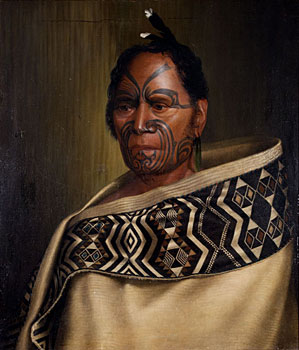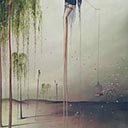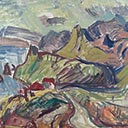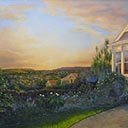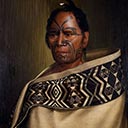Kawhena - 'Johnny Coffin' 1892
77.3 x 67 cm
est. $600,000 - 800,000
Provenance:
Private Collection, Wellington
Formally in the collection of C F Goldie's mother, Maria Partington. Kawhena has hung on loan in the Wellington Club since 1999
Exhibited:
Auckland Academy of Fine Art - December 1892 - Silver medal winning entry
Bishop Suter Art Gallery Loan Collection, Nelson 1976 - c. 1984
GOLDIE - The Exhibition, 1997 - 1999 Auckland Art Gallery Toi O Tamaki, Te Papa Tongarewa, Christchurch Art Gallery, Dunedin Art Gallery, Art Gallery of NSW
Illustrated: p. 161 C F Goldie His Life & Painting, Alister Taylor & Jan Glen, Alister Taylor publishing 1977
p. 63 GOLDIE Roger Blackley, Auckland Art Gallery Toi o Tamaki, Bateman 1997
Hone Kawhena aka Johnny Coffin b. 1825, of the Ngati Mahuta tribe was best known in the early days as a police constable of Auckland town. At the time, it was customary practice for a Maori and Pakeha constable to carry out their duties, patrolling the streets of Auckland in teams of two.
In 1851 Hone Kawhea and his Pakeha colleague arrested a chief of the Ngati Paoa tribe. This event led to the historical Ngati Paoa invasion of Auckland.
In 1892 Goldie painted Kawhena from life. With a stylistic maturity well beyond his years, the artist captures the strength, vitality and dignity of his sixty seven year old subject. Kawhena is adorned with status-defining huia feathers, intricately woven cloak and pounamu earring. Interestingly, the tattooing above his left brow is incomplete. Kawhena's explanation for this, was that it was simply too painful to endure. Kawhena died in 1900 and is buried at Mangere Cemetery, Auckland
Reference:
Goldie understandably stood aloof from the following year's exhibition of the Society of Arts. He was busy preparing for his overseas education, for which he had settled on Paris. Steele had trained at the Ecole des Beaux-Arts and subsequently worked as an artist in Paris, delighting Goldie with his tales of Bohemian life in the great city. Goldie also painted two outstanding works which appeared at the Academy's third and final exhibition of December 1892. One was an exquisite landscape depicting fern trees in Cemetery Gully, the area beneath the present Grafton Bridge, which received rave reviews for its exceptional detail. And for the first time he entered a work in the category of 'Maori Head', a depiction of Kawhena from Mangere (known also as Johnny Coffin). This is Goldie's first recorded Maori portrait and drew the following comment from the Star's jaded reviewer. Not knowing the original, one cannot say whether it is a good portrait of the individual or the reverse, but as a picture of a type it is fair. The painter has managed to fix in the eyes something of that expression of conscious mental inferiority which lurks in the eyes of the most intelligent of the lower animals and in semi-civilised man.
He, however, has had some trouble to know what to do with his light. The figuring on the mat is a careful piece of work, and the effect is very successful.
The writer evidently did not anticipate Kawhena numbering among the readers of his column. In the Academy's list of prizes, the result of a democratic ballot among the members, Goldie received a silver medal for both New Zealand Trees and Kawhena.
Goldie missed the exhibition, receiving his medals in absentia, for he had already left Auckland. His first port of call was Sydney, where in late November he attempted to sell his still life painting through Callan and Sons, prominent art dealers in George Street.
Text: p. 6 & 7, GOLDIE Roger Blackley, Auckland Art Gallery Toi o Tamaki, Bateman 1997
View pages from catalogue that relate to this lot PDF (200KB)

